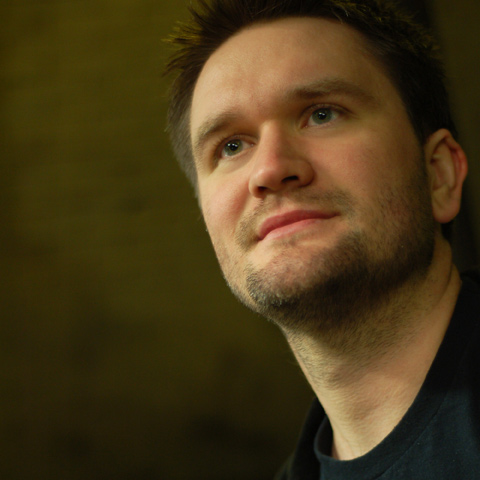
POINT COUNTERPOINT For his sextet, Tom Wetmore writes jazz with a funk-pop sheen and the weaving lines of alto saxophone and two lead guitars. |
Tom Wetmore's new The Desired Effect (Crosstown) is both tantalizingly familiar and utterly strange. Which is a good effect indeed. The familiarity is in the vaguely funk rhythms and textures he creates on Fender Rhodes electric piano with electric bassist Michael League and drummer Garrett Brown, and in the sinuous funk-pop melodies stated by saxophonists Jaleel Shaw and Eric Neveloff, or the occasional soaring guitar lines from Brad Williams and Justin Sabaj. And yet, nothing is exactly where you'd expect it to be — instead of repetitive grooves, League lays down odd patterns and counter-melodies. And just try to count. A tune often feels like 4/4, but never quite is.
When I get Wetmore on the phone at his home in Paterson, New Jersey, he unravels a bit of the mystery for me. What's going on in the pretty album-opener, "Red Lights," for instance? "It's a bunch of 4/4 and then whenever I want to take away a beat or add one, I do. . . . The B section is in 9/4." As we go through the album, every song has a similar story. Something that's "mostly in 3/4, then add a beat or take one away." And yes, there are odd meters, too, like 6/4, 7/4, and 5/4. But there's nothing math-y about the effect — in fact, it might be the rhythmic unpredictability that contributes to the overall dreamlike wave of the sound. It's a groove, for sure, but never typical. It's also worth pointing out that Wetmore identifies Stevie Wonder as one of his major influences.
"I feel like most music comes out the length it's supposed to be in the person's mind, but then they say, 'Let's write this down,' and they write 4/4 on a page and then figure out a way to make it fit. And that's fine, it makes music that's very satisfying in many ways. But for my process it makes more sense to say, 'Okay I just invented this line, let's write it down naturally, the way it really is, which is 15 beats long instead of 16 beats long.'" He concedes that his process makes for a more challenging performance situation. "If you take a beat off at the end of a line, it really throws everything off — if you're trying to count, or trying to dance, you'll think you've been doing it wrong the entire time."
It's not that odd-length phrasing and fucked-with meters are all that unusual — certainly not for someone who writes in a more free style. But Wetmore's pieces are tight. Though there are sparkling solos throughout the album (over more regular grooves), it's the overall sound of the pieces, the ensemble feel, that sticks with you. Most impressive is the three-way counterpoint that Wetmore explores — often with the lead saxophone playing the melody while both guitars weave contrapuntal lines underneath. In essence both guitars play lead. So you're always getting a bright pop sheen on the surface with a complex pattern of inner voices below.